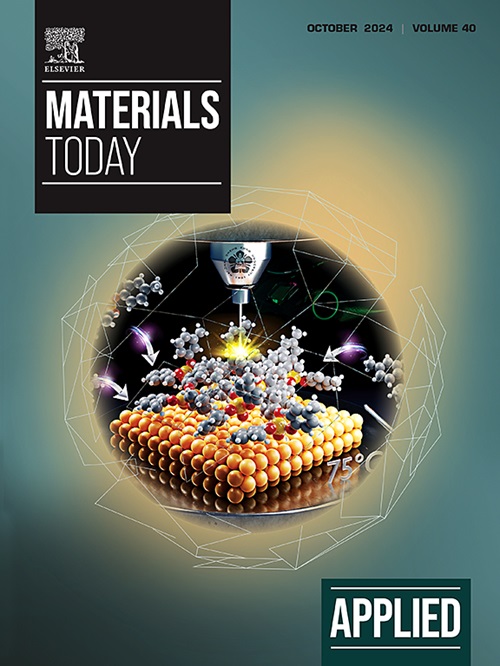Gradient ceramic structures via multi-material direct ink writing
IF 6.9
2区 材料科学
Q1 MATERIALS SCIENCE, MULTIDISCIPLINARY
引用次数: 0
Abstract
Dense boron carbide-silicon carbide specimens with composition tailored at the mesoscale were produced by direct ink write additive manufacturing in three configurations: I, 2 % and II, 10 % compositional layer-to-layer steps, and III, homogeneous composition throughout. Flexural strength, indicative of tensile failure, is the highest for the Type-II design (366 MPa) due to its compressive residual stress state in the surface layers. Analysis of thermally-induced residual stresses predicts the ranking of the flexural strengths obtained for Type-II (highest), Type-I (intermediate), and Type-III (lowest) specimens. Compressive strength is load-orientation independent, highly strain-rate dependent, and reduced for specimens with thermal residual stress. Mechanical tests were performed in cube and dumbbell geometries. Dumbbell geometry compression specimens have a compressive strength that is 68 % (quasistatic) and 86 % (dynamic) higher than that of cube geometry and show a greater strain rate dependence. The rate dependency is attributed to the competition between crack propagation and loading velocities. Type-I dumbbells show the highest mean compressive strength of 3.96 GPa (quasi-static) and 5.11 GPa (dynamic). The failure mode evolves from mixed intergranular/transgranular at low strain rates to transgranular at high strain rates. High-speed video analysis indicates that dumbbell geometry specimens fail in compression due to microcrack growth and coalescence, while cubes fail due to the axial macrocracks that develop at the specimen/load platen interface and propagate into the specimen parallel to the loading direction (end splitting). This work demonstrates the impact of compositional variation, tailored by additive manufacturing, on the mechanical performance of ceramic composites.通过多材料直接墨水书写技术实现梯度陶瓷结构
通过三种配置的直接墨水写入增材制造技术生产出了中尺度成分定制的致密碳化硼-碳化硅试样:I 型:2 % 和 II 型:10 % 的层间成分阶跃;III 型:整体成分均匀。由于表层的压缩残余应力状态,表明拉伸失效的挠曲强度在 II 型设计中最高(366 兆帕)。对热引起的残余应力的分析预测了 II 型试样(最高)、I 型试样(中等)和 III 型试样(最低)的抗弯强度排名。抗压强度与载荷方向无关,与应变速率高度相关,并降低了热残余应力试样的抗压强度。机械测试采用立方体和哑铃几何形状。哑铃形压缩试样的压缩强度比立方体试样高出 68%(准静态)和 86%(动态),并显示出更大的应变速率依赖性。应变速率依赖性是由于裂纹扩展和加载速度之间的竞争造成的。I 型哑铃的平均抗压强度最高,为 3.96 GPa(准静态)和 5.11 GPa(动态)。失效模式从低应变速率下的混合晶间/透晶演变为高应变速率下的透晶。高速视频分析表明,哑铃形试样在压缩过程中由于微裂纹生长和凝聚而失效,而立方体试样则由于轴向大裂纹而失效,这些裂纹在试样/载荷压盘界面处产生,并平行于加载方向扩展到试样中(端部分裂)。这项工作证明了通过增材制造定制的成分变化对陶瓷复合材料机械性能的影响。
本文章由计算机程序翻译,如有差异,请以英文原文为准。
求助全文
约1分钟内获得全文
求助全文
来源期刊

Applied Materials Today
Materials Science-General Materials Science
CiteScore
14.90
自引率
3.60%
发文量
393
审稿时长
26 days
期刊介绍:
Journal Name: Applied Materials Today
Focus:
Multi-disciplinary, rapid-publication journal
Focused on cutting-edge applications of novel materials
Overview:
New materials discoveries have led to exciting fundamental breakthroughs.
Materials research is now moving towards the translation of these scientific properties and principles.
 求助内容:
求助内容: 应助结果提醒方式:
应助结果提醒方式:


